Effect of Different Proportions of Three Microbial Agents on Ammonia Mitigation during the Composting of Layer Manure
Abstract
:1. Introduction
2. Results
2.1. Ammonia Emissions
2.2. Variation in Temperature during Composting
2.3. Variation in pH during Composting
2.4. Variation in Moisture Content during Composting
2.5. Variation in Organic Matter during Composting
2.6. Variation in Total Nitrogen during Composting
2.7. Variation in Ammonium Nitrogen during Composting
2.8. Variation in Nitrate Nitrogen during Composting
2.9. Variation in the C/N Ratio during Composting
2.10. The Variation in Absolute Abundance of Total Bacteria (TB) in Different Groups
2.11. The Variation in Absolute Abundance of Ammonia-Oxidizing Bacteria (AOB) in Different Groups
3. Discussion
4. Materials and Methods
4.1. Composting Materials
4.2. Experimental Design
4.3. Sample Collection
4.4. Analytical Methods
4.4.1. Gaseous Measurements
4.4.2. Physicochemical Analyses
4.4.3. Total DNA Extraction and qPCR
5. Conclusions
Author Contributions
Funding
Conflicts of Interest
Appendix A
Appendix A.1. Growth Curve Test of Strains
Appendix A.2. Recovery Test
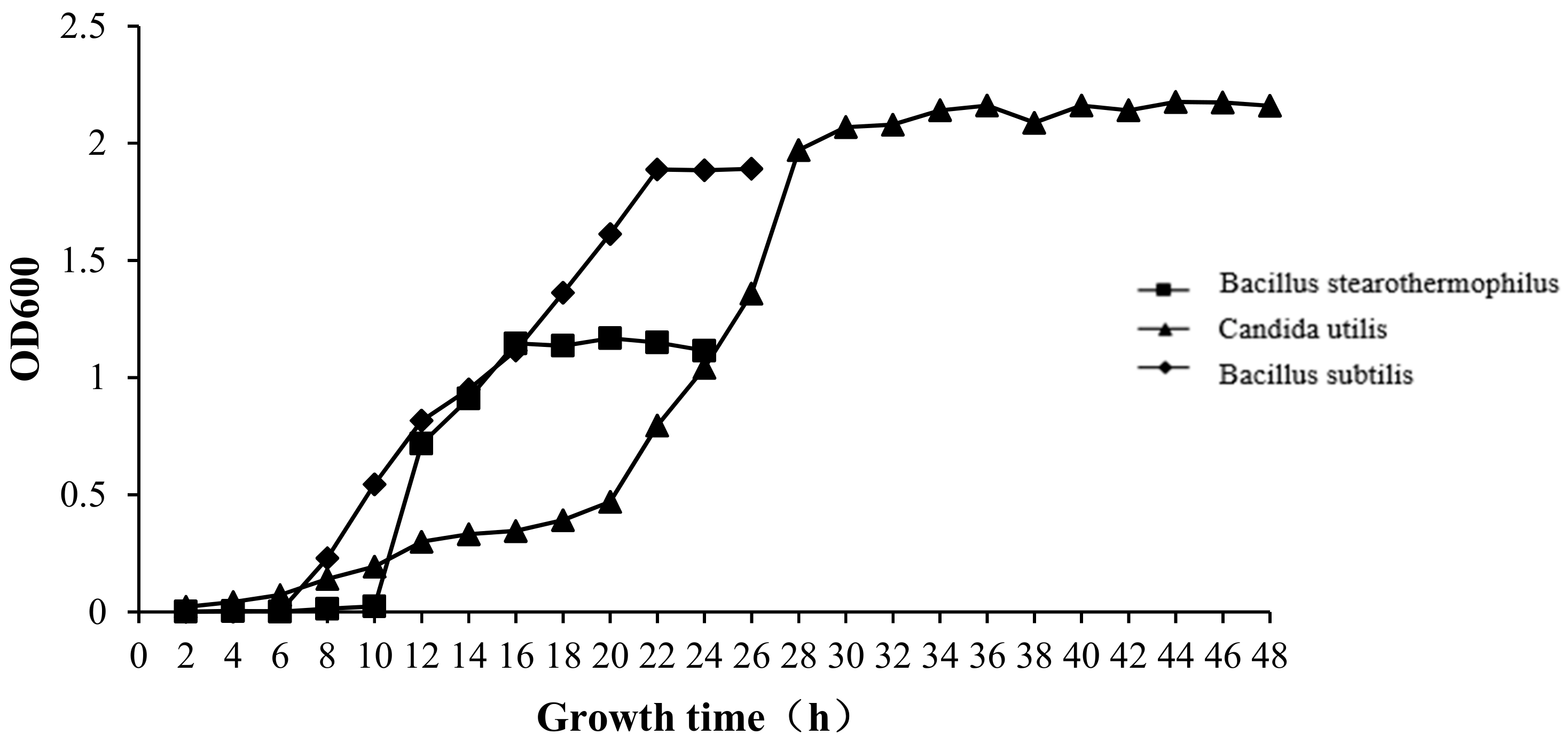
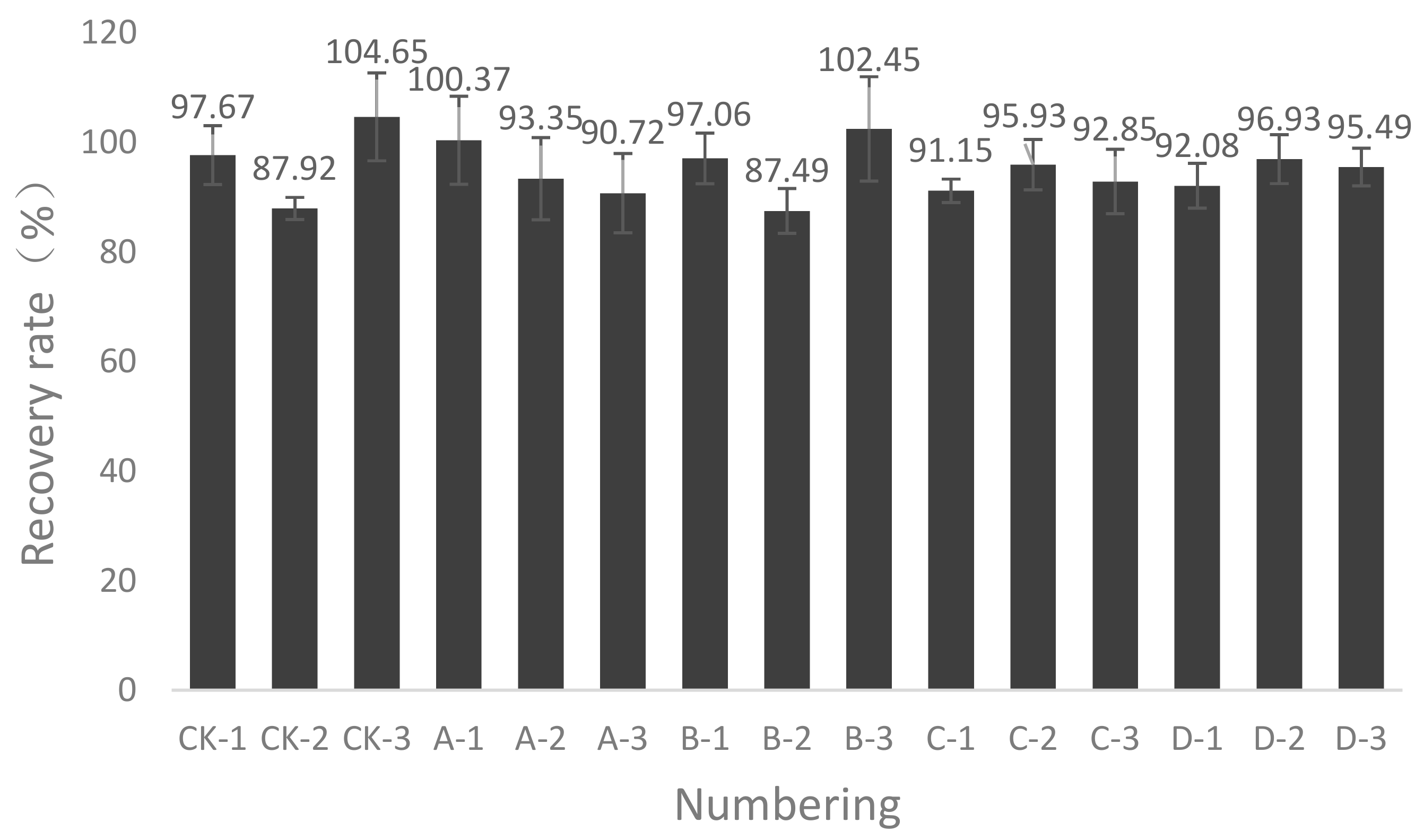
References
- Pan, D. The Design of Policy Instruments Towards Sustainable Livestock Production in China: An Application of the Choice Experiment Method. Sustainability 2016, 8, 611. [Google Scholar] [CrossRef]
- Bernal, M.P.; Alburquerque, J.A.; Moral, R. Composting of Animal Manures and Chemical Criteria for Compost Maturity Assessment. A Review. Bioresour. Technol. 2009, 100, 5444–5453. [Google Scholar] [CrossRef] [PubMed]
- Külcü, R.; Yaldiz, O. The Composting of Agricultural Wastes and the New Parameter for the Assessment of the Process. Ecol. Eng. 2014, 69, 220–225. [Google Scholar] [CrossRef]
- Li, J.T.; Zhong, X.L.; Wang, F.; Zhao, Q.G. Effect of Poultry Litter and Livestock Manure on Soil Physical and Biological Indicators in a Rice-Wheat Rotation System. Plant. Soil Environ. 2011, 57, 351–356. [Google Scholar] [CrossRef]
- Ni, J.Q.; Heber, A.J.; Hanni, S.M.; Lim, T.T.; Diehl, C.A. Characteristics of Ammonia and Carbon Dioxide Releases from Layer Hen Manure. Br. Poult. Sci. 2010, 51, 326–334. [Google Scholar] [CrossRef] [PubMed]
- Pratt, C.; Redding, M.; Hill, J.; Jensen, P.D. Does Manure Management Affect the Latent Greenhouse Gas Emitting Potential of Livestock Manures? Waste Manag. 2015, 46, 568–576. [Google Scholar] [CrossRef] [PubMed]
- Soto-Herranz, M.; Sánchez-Báscones, M.; Antolín-Rodríguez, J.M.; Conde-Cid, D.; Vanotti, M.B. Effect of the Type of Gas-Permeable Membrane in Ammonia Recovery from Air. Environments 2019, 6, 70. [Google Scholar] [CrossRef]
- Paula, A.; Mourinha, C.; Farto, M.; Santos, T.; Palma, P.; Sengo, J.; Morais, M.C.; Cunha-Queda, C. Sewage Sludge, Compost and Other Representative Organic Wastes as Agricultural Soil Amendments: Benefits Versus Limiting Factors. Waste Manag. 2015, 40, 44–52. [Google Scholar]
- De Guardia, A.D.; Petiot, C.; Rogeau, D.; Druilhe, C. Influence of Aeration Rate on Nitrogen Dynamics During Composting. Waste Manag. 2008, 28, 575–587. [Google Scholar] [CrossRef] [PubMed]
- Mao, I.F.; Tsai, C.J.; Shen, S.H.; Lin, T.F.; Chen, W.K.; Chen, M.L. Critical Components of Odors in Evaluating the Performance of Food Waste Composting Plants. Sci. Total Environ. 2006, 370, 323–329. [Google Scholar] [CrossRef]
- Nakhshiniev, B.; Perera, C.; Biddinika, M.K.; Gonzales, H.B.; Sumida, H.; Yoshikawa, K. Reducing Ammonia Volatilization During Composting of Organic Waste through Addition of Hydrothermally Treated Lignocellulose. Int. Biodeterior. Biodegrad. 2014, 96, 58–62. [Google Scholar] [CrossRef]
- Pagans, E.; Barrena, R.; Font, X.; Sánchez, A. Ammonia Emissions from the Composting of Different Organic Wastes. Dependency on Process Temperature. Chemosphere 2006, 62, 1534–1542. [Google Scholar] [CrossRef]
- Barrington, S.; Choinière, D.; Trigui, M.; Knight, W. Effect of Carbon Source on Compost Nitrogen and Carbon Losses. Bioresour. Technol. 2002, 83, 189–194. [Google Scholar] [CrossRef]
- Veeken, A.; de Wilde, V.; Hamelers, B. Passively Aerated Composting of Straw-Rich Pig Manure: Effect of Compost Bed Porosity. Compos. Sci. Util. 2002, 10, 114–128. [Google Scholar] [CrossRef]
- Mahimairaja, S.; Bolan, N.S.; Hedley, M.J.; Macgregor, A.N. Losses and Transformation of Nitrogen During Composting of Poultry Manure with Different Amendments: An Incubation Experiment. Bioresour. Technol. 1994, 47, 265–273. [Google Scholar] [CrossRef]
- Mi, J.; Chen, X.; Liao, X. Screening of Single or Combined Administration of 9 Probiotics to Reduce Ammonia Emissions from Laying Hens. Poult. Sci. 2019. [Google Scholar] [CrossRef]
- Bayoï, J.R.; Djoulde, D.R.; Kamga, P.B.; Nyegue, M.; Olugu, S.V.; Bakary, D.; Etoa, F.X. Activity of Acetic Acid on Bacillus Stearothermophilus and Bacillus Subtilis Spores after Sublethal Heat Pretreatments. Int. J. Innov. Sci. Res. 2014, 10, 570–575. [Google Scholar]
- Durand, L.; Planchon, S.; Guinebretiere, M.H.; Carlin, F.; Remize, F. Genotypic and Phenotypic Characterization of Foodborne Geobacillus Stearothermophilus. Food Microbiol. 2015, 45, 103–110. [Google Scholar] [CrossRef]
- Guizelini, P.B.; Vandenberghe, L.P.; Sella, S.R.; Soccol, C.R. Study of the Influence of Sporulation Conditions on Heat Resistance of Geobacillus Stearothermophilus Used in the Development of Biological Indicators for Steam Sterilization. Arch. Microbiol. 2012, 194, 991–999. [Google Scholar] [CrossRef]
- Choi, K.Y.; Wernick, D.G.; Tat, C.A.; Liao, J.C. Consolidated Conversion of Protein Waste into Biofuels and Ammonia Using Bacillus Subtilis. Metab. Eng. 2014, 23, 53–61. [Google Scholar] [CrossRef]
- Wang, D.; Wei, G.; Nie, M.; Chen, J. Effects of Nitrogen Source and Carbon/Nitrogen Ratio on Batch Fermentation of Glutathione by Candida Utilis. Korean J. Chem. Eng. 2010, 27, 551–559. [Google Scholar] [CrossRef]
- Sánchez, Ó.J.; Ospina, D.A.; Montoya, S. Compost Supplementation with Nutrients and Microorganisms in Composting Process. Waste Manag. 2017, 136–153. [Google Scholar] [CrossRef] [PubMed]
- Lim, L.Y.; Bong, C.P.; Chua, L.S.; Lee, C.T. Physicochemical Profile of Microbial-Assisted Composting on Empty Fruit Bunches of Oil Palm Trees. Environ. Sci. Pollut. Res. 2015, 22, 19814–19822. [Google Scholar] [CrossRef] [PubMed]
- Miyatake, F.; Iwabuchi, K. Effect of Compost Temperature on Oxygen Uptake Rate, Specific Growth Rate and Enzymatic Activity of Microorganisms in Dairy Cattle Manure. Bioresour. Technol. 2006, 97, 961–965. [Google Scholar] [CrossRef] [PubMed]
- Liang, C.; Das, K.C.; McClendon, R.W. The Influence of Temperature and Moisture Contents Regimes on the Aerobic Microbial Activity of a Biosolids Composting Blend. Bioresour. Technol. 2003, 86, 131–137. [Google Scholar] [CrossRef]
- McCrory, D.F.; Hobbs, P.J. Additives to Reduce Ammonia and Odor Emissions from Livestock Wastes. J. Environ. Qual. 2001, 30, 345–355. [Google Scholar] [CrossRef] [PubMed]
- Mor, S.; de Visscher, A.; Ravindra, K.; Dahiya, R.P.; Chandra, A.; van Cleemput, O. Induction of Enhanced Methane Oxidation in Compost: Temperature and Moisture Response. Waste Manag. 2006, 26, 381–388. [Google Scholar] [CrossRef] [PubMed]
- Agnew, J.M.; Leonard, J.J. The Physical Properties of Compost. Compos. Sci. Util. 2003, 11, 238–264. [Google Scholar] [CrossRef]
- Asano, R.; Otawa, K.; Ozutsumi, Y.; Yamamoto, N.; Abdel-Mohsein, H.S.; Nakai, Y. Development and Analysis of Microbial Characteristics of an Acidulocomposting System for the Treatment of Garbage and Cattle Manure. J. Biosci. Bioeng. 2010, 110, 419–425. [Google Scholar] [CrossRef] [PubMed]
- Hou, J.; Li, M.; Xia, T.; Hao, Y.; Ding, J.; Liu, D.; Xi, B.; Liu, H. Simultaneous Removal of Ammonia and Hydrogen Sulfide Gases Using Biofilter Media from the Biodehydration Stage and Curing Stage of Composting. Environ. Sci. Pollut. Res. 2016, 23, 20628–20636. [Google Scholar] [CrossRef]
- Yan, Z.; Liu, X.; Yuan, Y.; Liao, Y.; Li, X. Deodorization Study of the Swine Manure with Two Yeast Strains. Biotechnol. Bioprocess Eng. 2013, 18, 135–143. [Google Scholar] [CrossRef]
- Darby, I.; Xu, C.Y.; Wallace, H.M.; Joseph, S.; Pace, B.; Bai, S.H. Short-Term Dynamics of Carbon and Nitrogen Using Compost, Compost-Biochar Mixture and Organo-Mineral Biochar. Environ. Sci. Pollut. Res. 2016, 23, 11267–11278. [Google Scholar] [CrossRef] [PubMed]
- Mao, H.; Lv, Z.; Sun, H.; Li, R.; Zhai, B.; Wang, Z.; Awasthi, M.K.; Wang, Q.; Zhou, L. Improvement of Biochar and Bacterial Powder Addition on Gaseous Emission and Bacterial Community in Pig Manure Compost. Bioresour. Technol. 2018, 195–202. [Google Scholar] [CrossRef] [PubMed]
- Liang, G.; Liao, X.; Du, G.; Chen, J. A New Strategy to Enhance Glutathione Production by Multiple H2o2-Induced Oxidative Stresses in Candida Utilis. Bioresour. Technol. 2009, 100, 350–355. [Google Scholar] [CrossRef]
- Awasthi, M.K.; Wang, Q.; Awasthi, S.K.; Wang, M.; Chen, H.; Ren, X.; Zhao, J.; Zhang, Z. Influence of Medical Stone Amendment on Gaseous Emissions, Microbial Biomass and Abundance of Ammonia Oxidizing Bacteria Genes During Biosolids Composting. Bioresour. Technol. 2018, 970–979. [Google Scholar] [CrossRef]
- Yao, H.; Gao, Y.; Nicol, G.W.; Campbell, C.D.; Prosser, J.I.; Zhang, L.; Han, W.; Singh, B.K. Links between Ammonia Oxidizer Community Structure, Abundance, Nitrification Potential in Acidic Soils. Appl. Environ. Microbiol. 2011, 77, 4618–4625. [Google Scholar] [CrossRef]
- Jiang, J.; Liu, X.; Huang, Y.; Huang, H. Inoculation with Nitrogen Turnover Bacterial Agent Appropriately Increasing Nitrogen and Promoting Maturity in Pig Manure Composting. Waste Manag. 2015, 39, 78–85. [Google Scholar] [CrossRef]
- Chen, W.; Liao, X.; Wu, Y.; Liang, J.B.; Mi, J.; Huang, J.; Zhang, H.; Wu, Y.; Qiao, Z.; Li, X. Effects of Different Types of Biochar on Methane and Ammonia Mitigation During Layer Manure Composting. Waste Manag. 2017, 61, 506–515. [Google Scholar] [CrossRef]
- Chowdhury, M.A.; de Neergaard, A.; Jensen, L.S. Composting of Solids Separated from Anaerobically Digested Animal Manure: Effect of Different Bulking Agents and Mixing Ratios on Emissions of Greenhouse Gases and Ammonia. Biosyst. Eng. 2014, 124, 63–77. [Google Scholar] [CrossRef]
- Malińska, K.; Zabochnicka-Świątek, M.; Dach, J. Effects of Biochar Amendment on Ammonia Emission During Composting of Sewage Sludge. Ecol. Eng. 2014, 71, 474–478. [Google Scholar]
- Bari, Q.H.; Koenig, A. Application of a Simplified Mathematical Model to Estimate the Effect of Forced Aeration on Composting in a Closed System. Waste Manag. 2012, 32, 2037–2045. [Google Scholar] [CrossRef] [PubMed]
- Jiang, T.; Li, G.; Tang, Q.; Ma, X.; Wang, G.; Schuchardt, F. Effects of Aeration Method and Aeration Rate on Greenhouse Gas Emissions During Composting of Pig Feces in Pilot Scale. J. Environ. Sci. 2015, 31, 124–132. [Google Scholar] [CrossRef] [PubMed]
- Wang, J.; Du, X.; Zhang, Y.; Li, T.; Liao, X. Effect of Substrate on Identification of Microbial Communities in Poultry Carcass Composting and Microorganisms Associated with Poultry Carcass Decomposition. J. Agric. Food Chem. 2016, 64, 6838–6847. [Google Scholar] [CrossRef] [PubMed]
- Wang, Y.; Bi, L.; Liao, Y.; Lu, D.; Zhang, H.; Liao, X.; Liang, J.B.; Wu, Y. Influence and Characteristics of Bacillus Stearothermophilus in Ammonia Reduction During Layer Manure Composting. Ecotoxicol. Environ. Saf. 2019, 180, 80–87. [Google Scholar] [CrossRef] [PubMed]
- Zhang, L.; Sun, X. Changes in Physical, Chemical, Microbiological Properties During the Two-Stage Co-Composting of Green Waste with Spent Mushroom Compost and Biochar. Bioresour. Technol. 2014, 171, 274–284. [Google Scholar] [CrossRef] [PubMed]
- Sun, P.; Li, J.; Bu, D.; Nan, X.; Du, H. Effects of Bacillus Subtilis Natto and Different Components in Culture on Rumen Fermentation and Rumen Functional Bacteria in Vitro. Curr. Microbiol. 2016, 72, 589–595. [Google Scholar] [CrossRef]
- Huang, G.F.; Wong, J.W.C.; Wu, Q.T.; Nagar, B.B. Effect of C/N on Composting of Pig Manure with Sawdust. Waste Manag. 2004, 24, 805–813. [Google Scholar] [CrossRef]
- Belyaeva, O.N.; Haynes, R.J. Chemical, Microbial and Physical Properties of Manufactured Soils Produced by Co-Composting Municipal Green Waste with Coal Fly Ash. Bioresour. Technol. 2009, 100, 5203–5209. [Google Scholar] [CrossRef]
- Bremner, J.M. Determination of Nitrogen in Soil by the Kjeldahl Method. J. Agric. Sci. 1960, 55, 11–33. [Google Scholar] [CrossRef]
- Haug, R.T. The Practical Handbook of Compost Engineering. CRC Press: Boca Raton, FL, USA, 1993. [Google Scholar]
- Petric, I.; Helić, A.; Avdić, E.A. Evolution of Process Parameters and Determination of Kinetics for Co-Composting of Organic Fraction of Municipal Solid Waste with Poultry Manure. Bioresour. Technol. 2012, 117, 107–116. [Google Scholar] [CrossRef]
- López-Cano, I.; Roig, A.; Cayuela, M.L.; Alburquerque, J.A.; Sánchez-Monedero, M.A. Biochar Improves N Cycling During Composting of Olive Mill Wastes and Sheep Manure. Waste Manag. 2016, 49, 553–559. [Google Scholar] [CrossRef] [PubMed]
- Yan, L.; Li, Z.; Wang, Y.; Gao, Y.; Wang, Y.; Gu, J.-D.; Wang, W. Diversity of Ammonia-Oxidizing Bacteria and Archaea in Response to Different Aeration Rates During Cattle Manure Composting. Ecol. Eng. 2016, 93, 46–54. [Google Scholar] [CrossRef]
- Kim, S.; Lee, S.; Kim, J.K.; Chung, H.J.; Jeon, J.S. Microfluidic-Based Observation of Local Bacterial Density under Antimicrobial Concentration Gradient for Rapid Antibiotic Susceptibility Testing. Biomicrofluidics 2019, 13, 014108. [Google Scholar] [CrossRef] [PubMed]
Sample Availability: Samples of the compounds are available from the authors. |
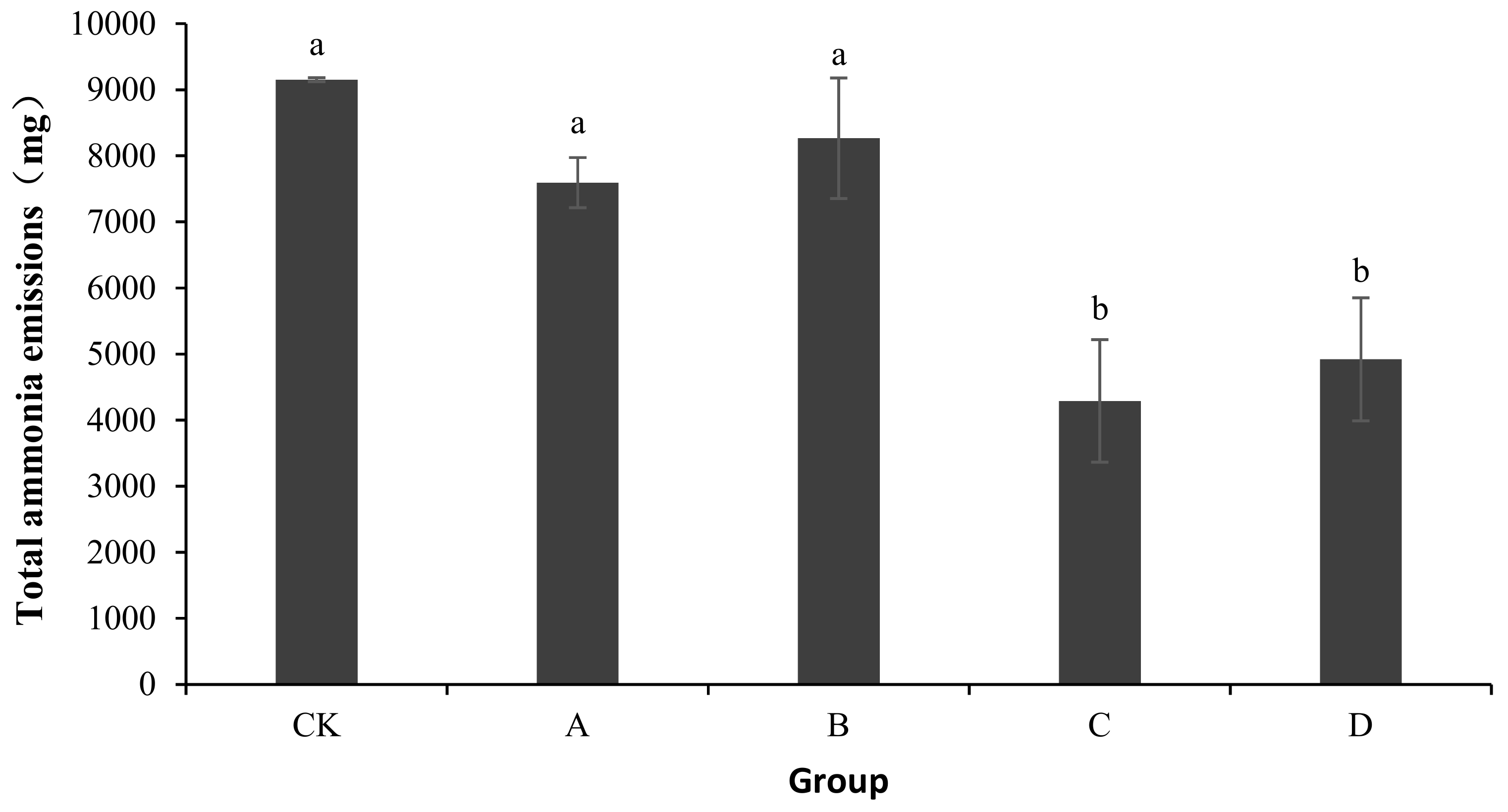
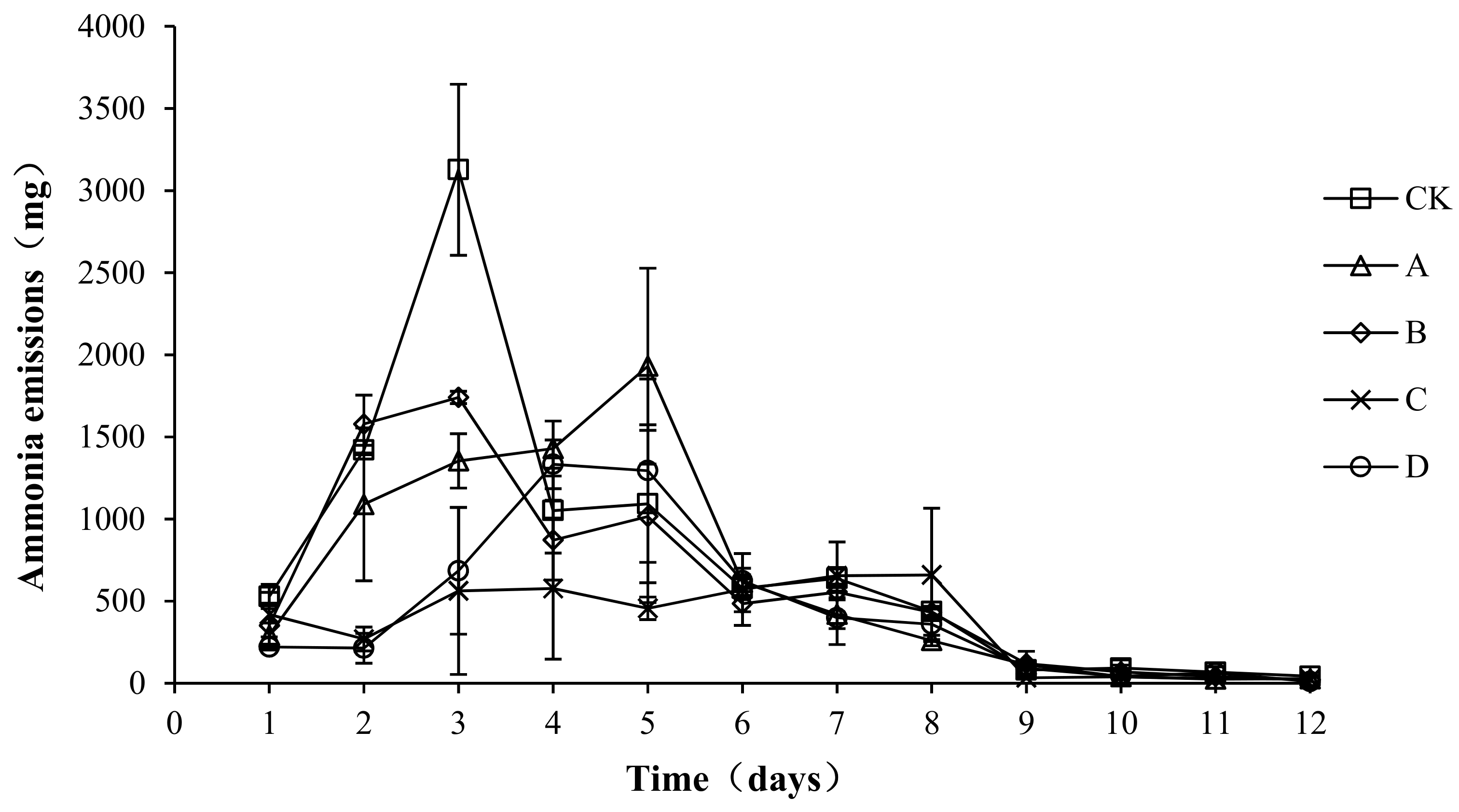
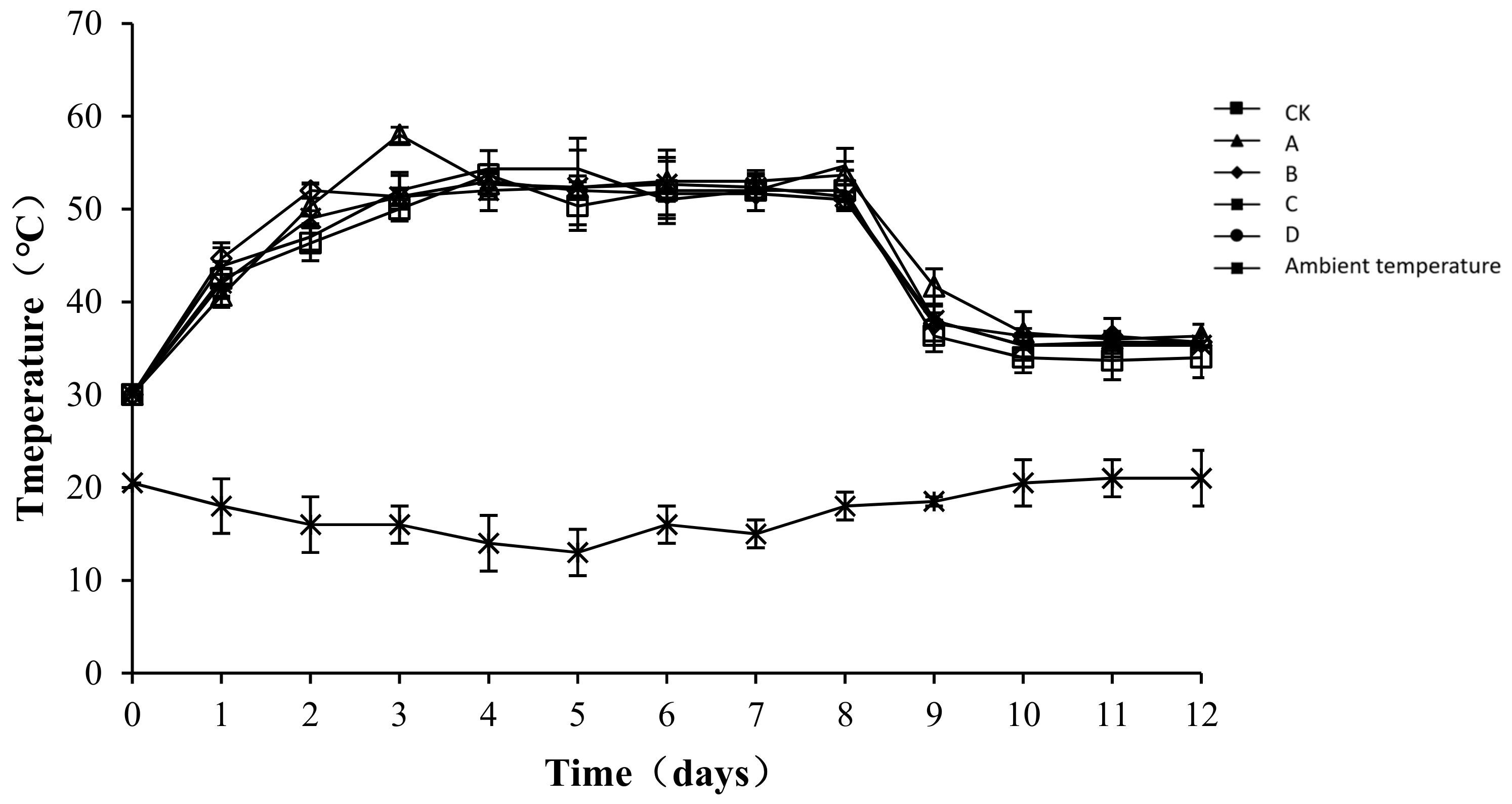
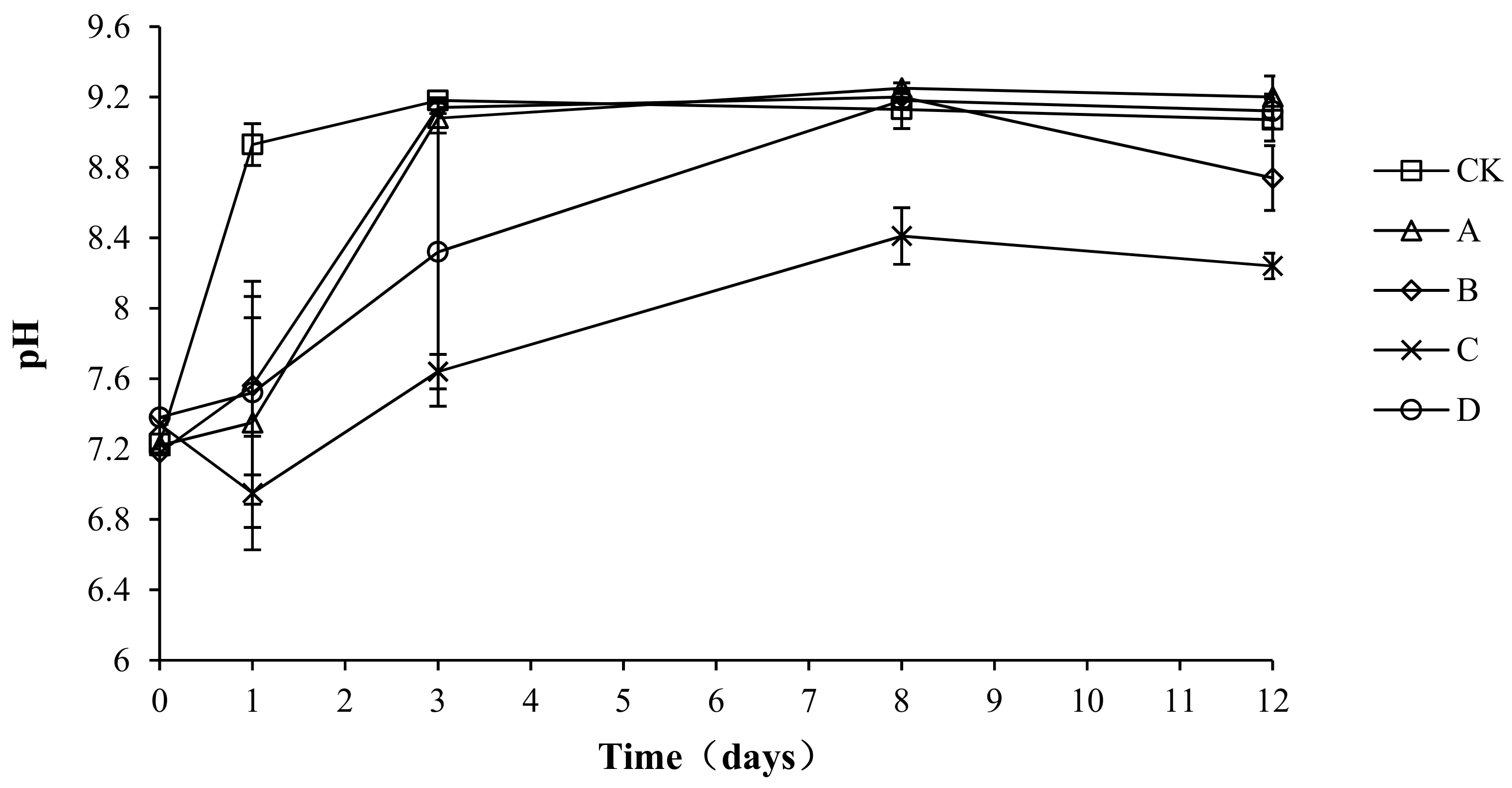
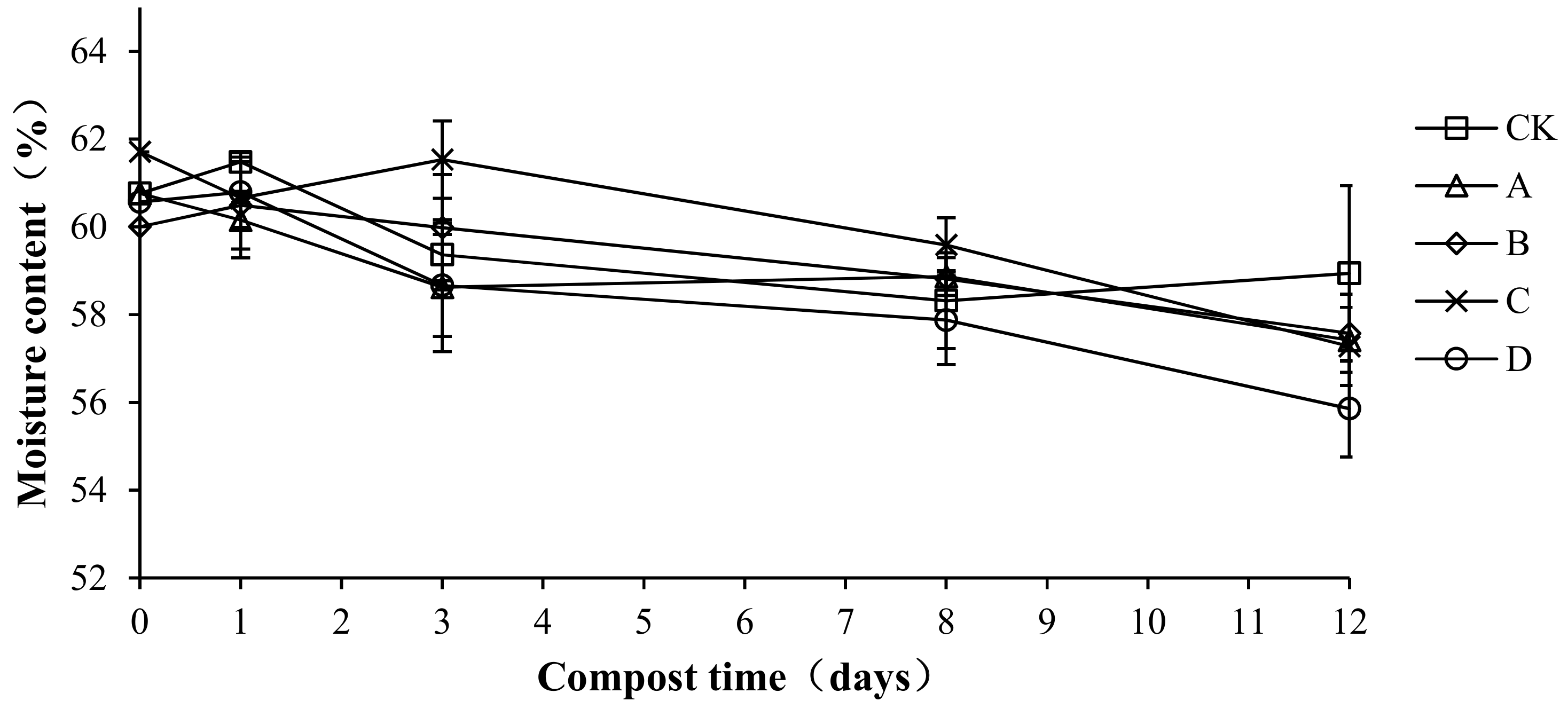
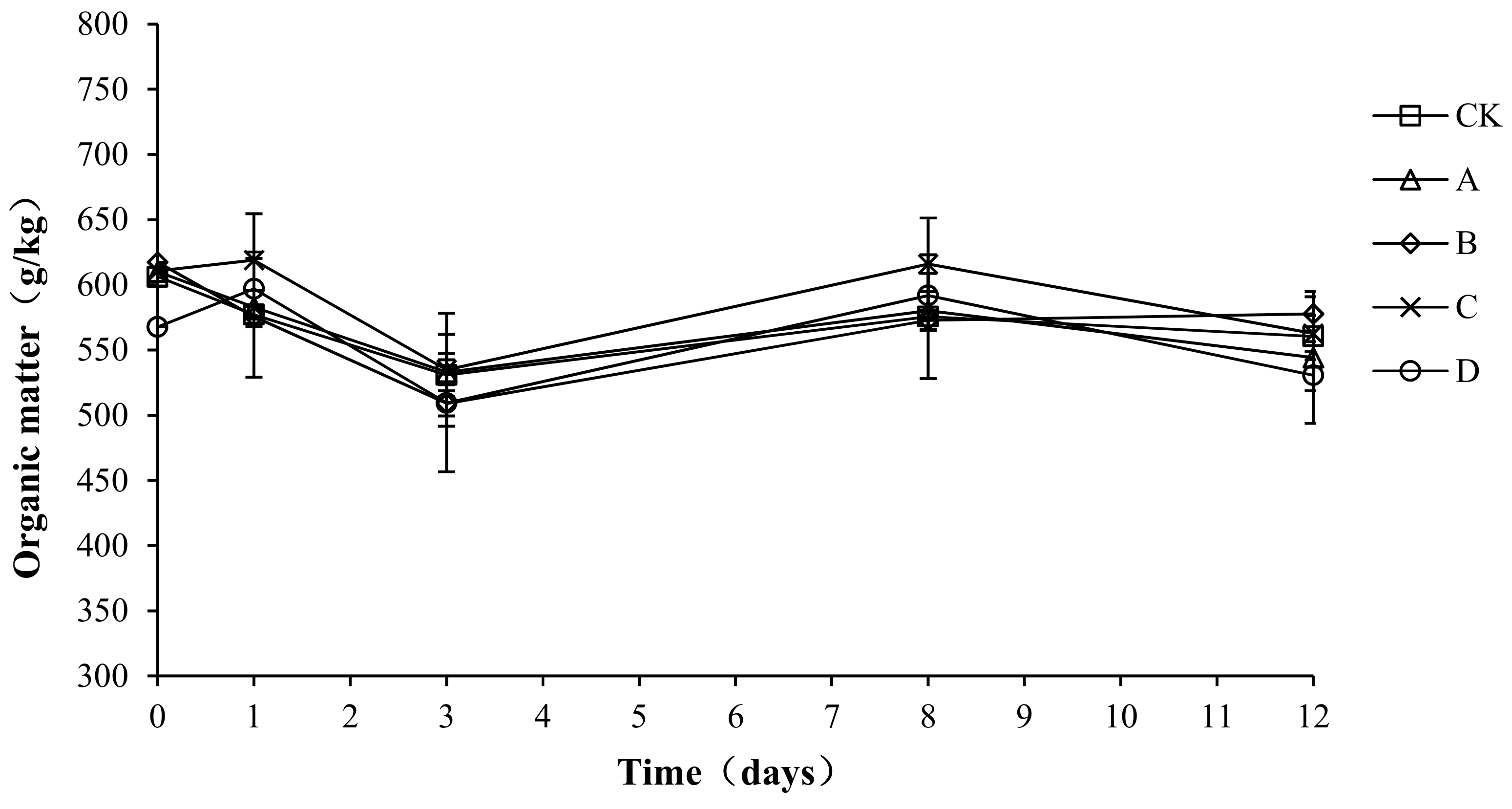
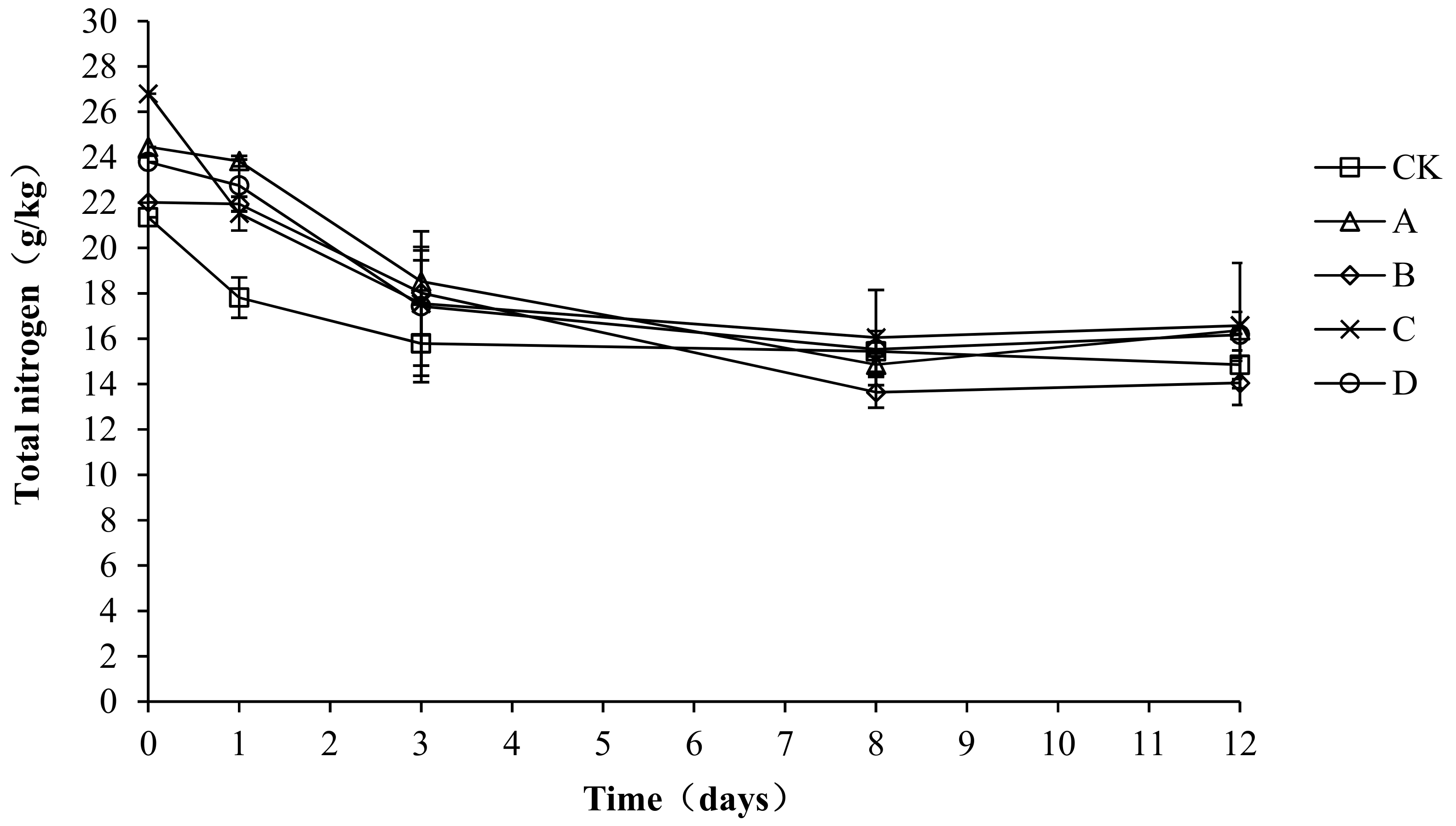
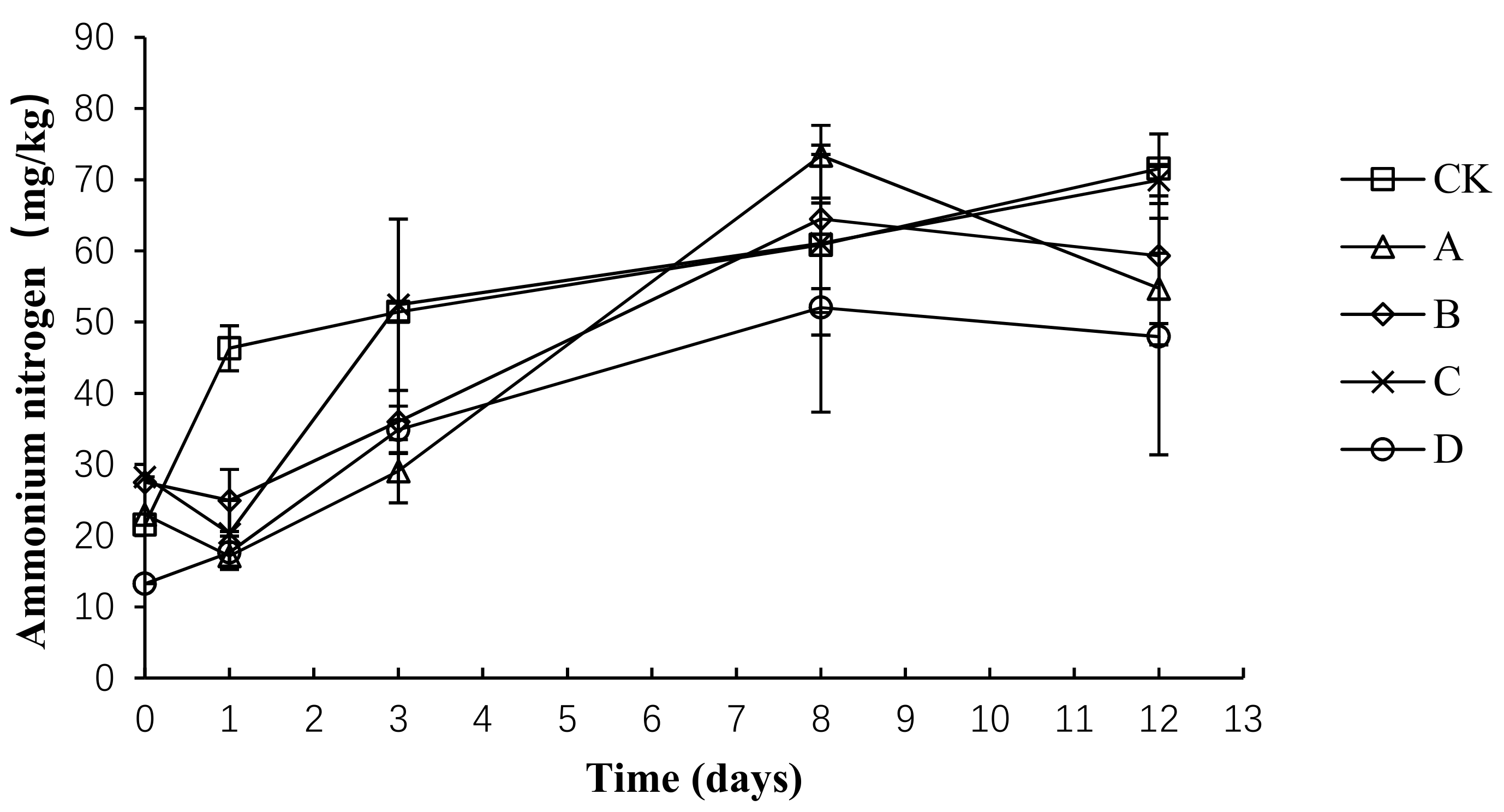
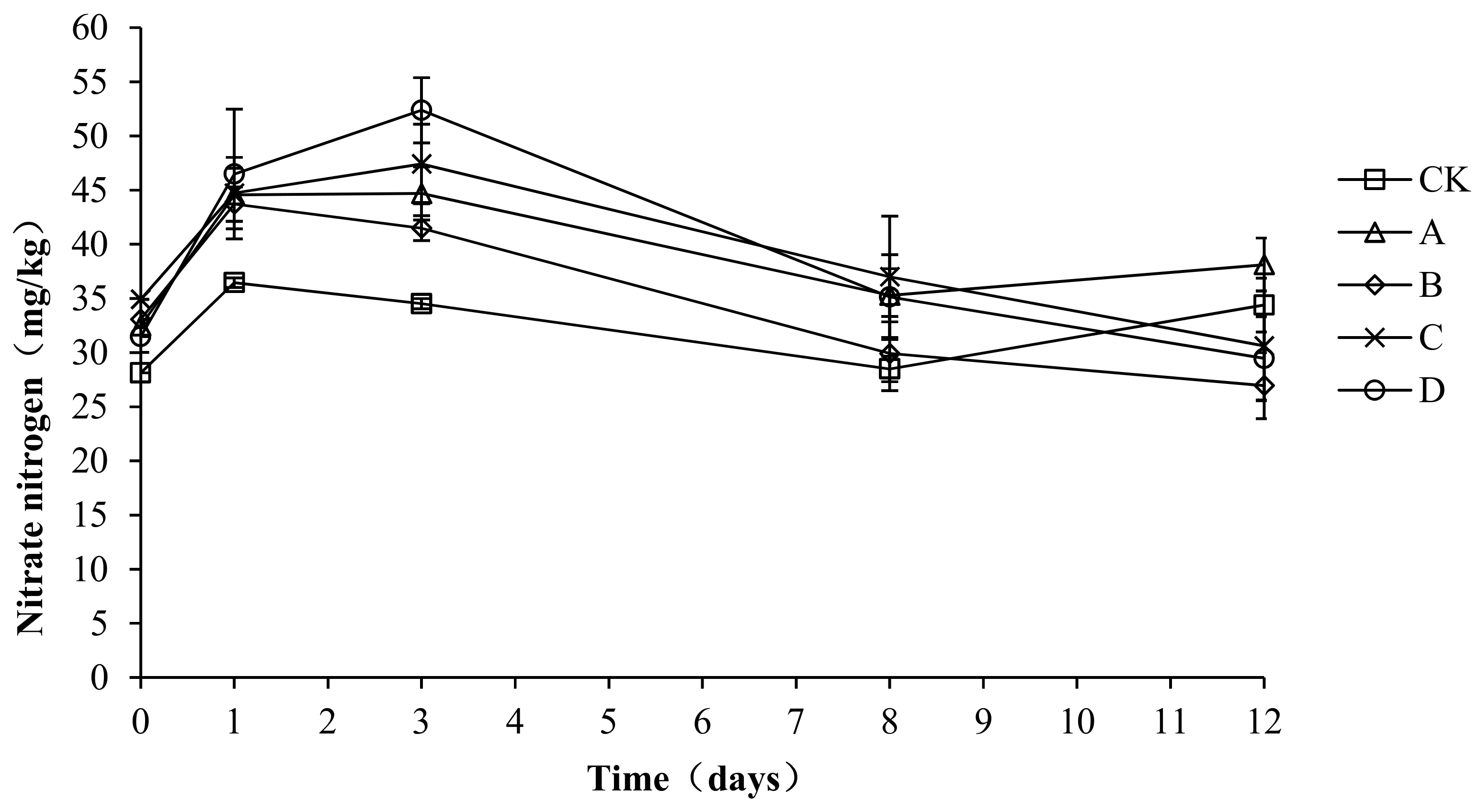
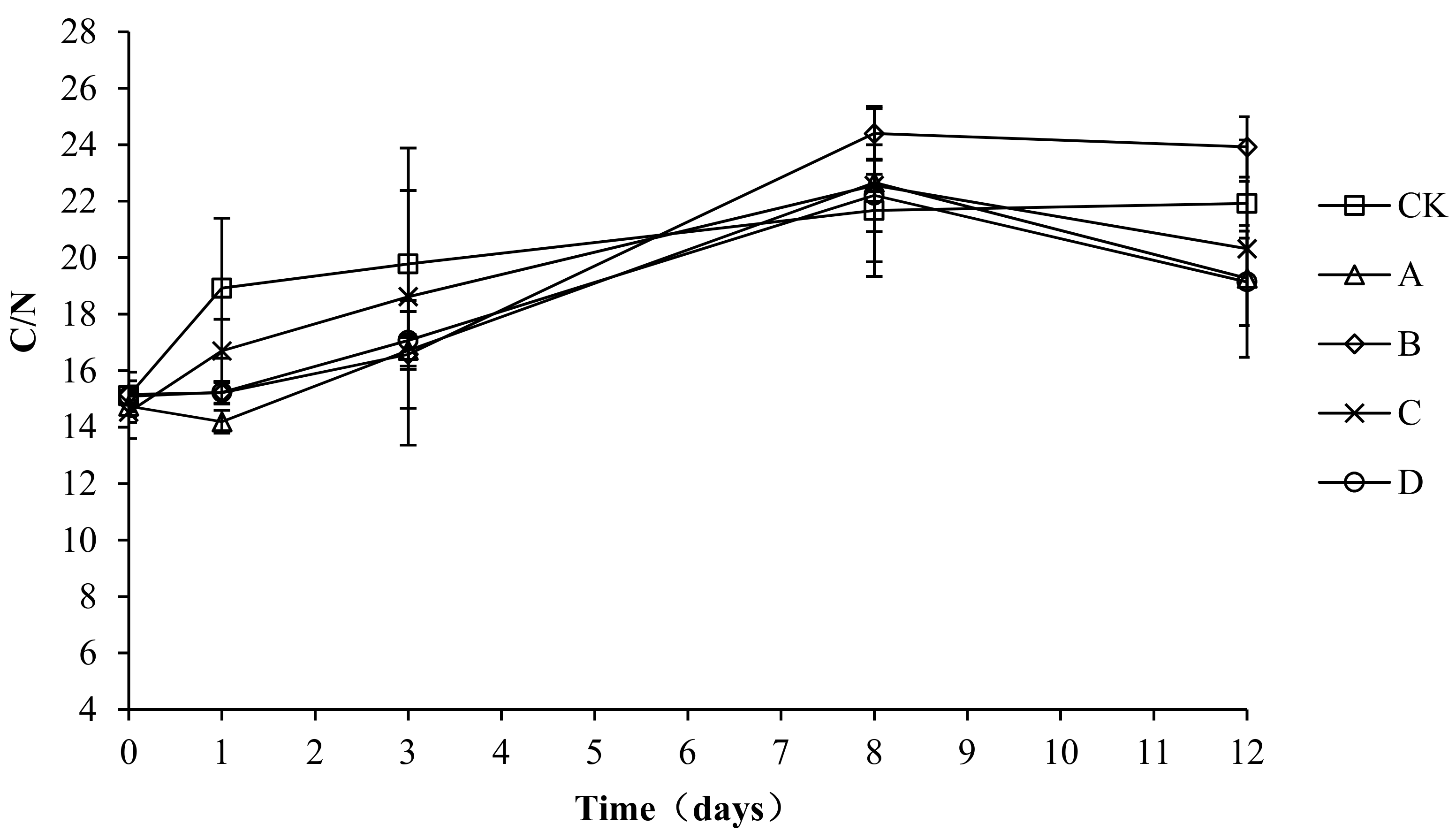
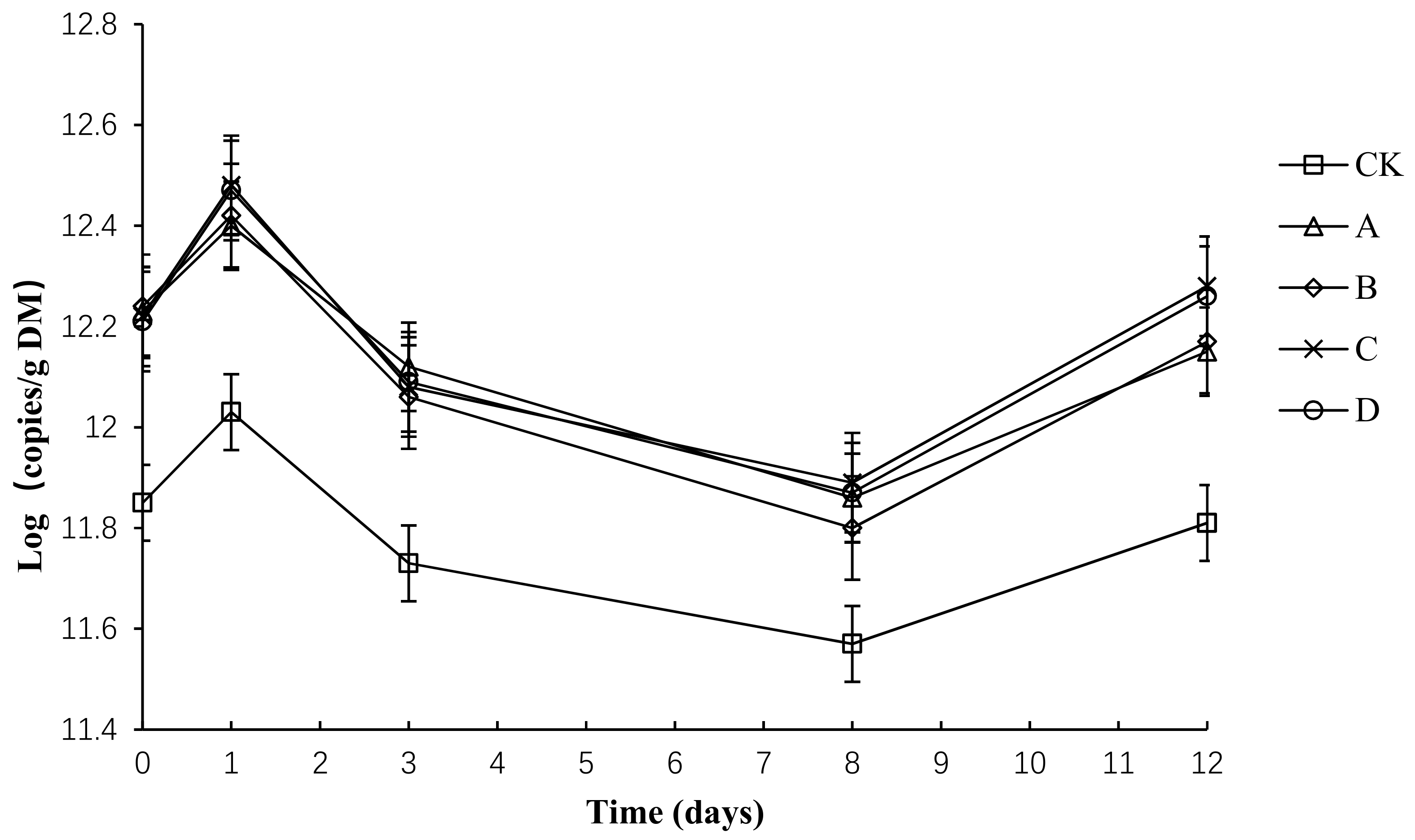
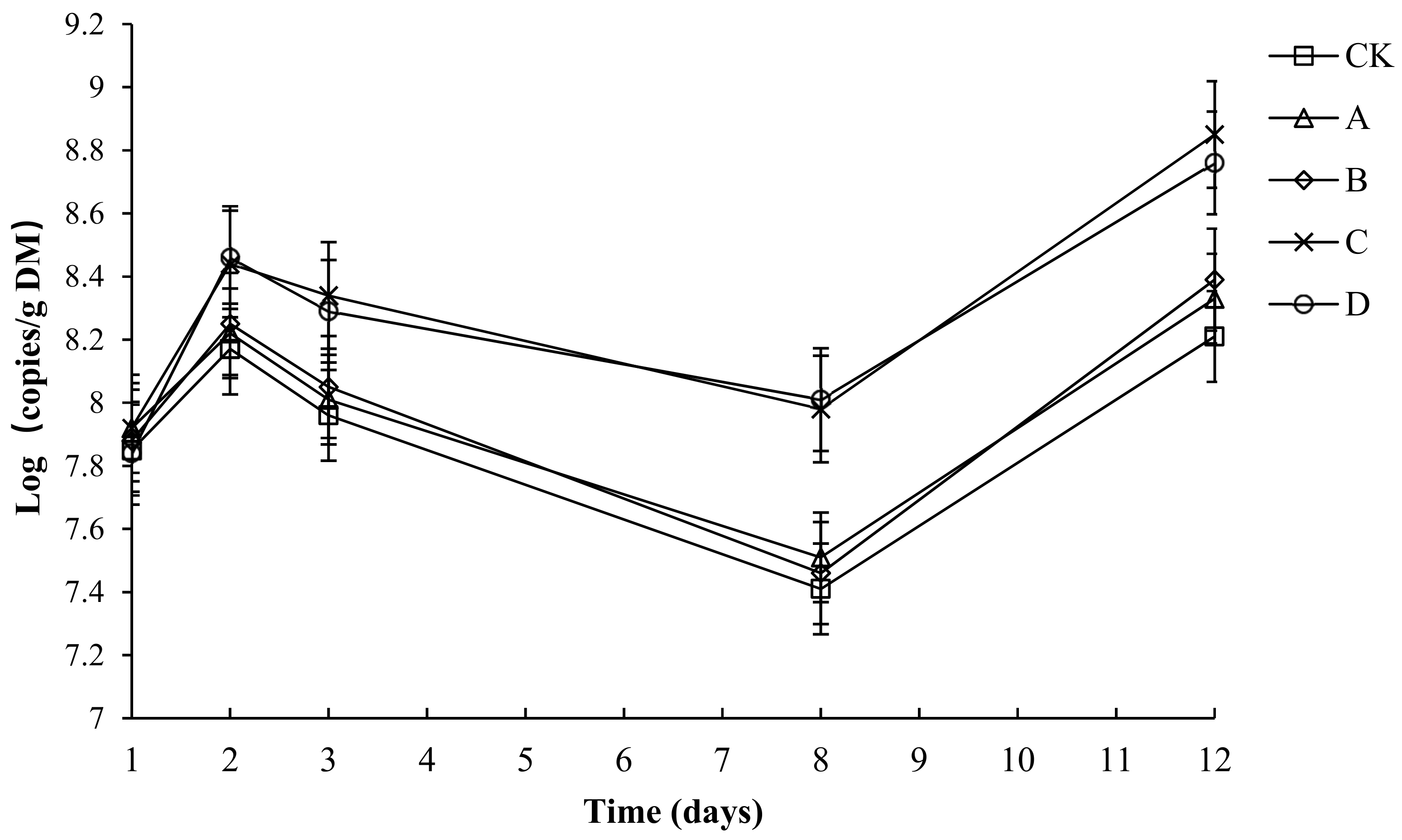
| Group | Moisture Content (%) | Total Carbon (%) | Total Nitrogen (%) | C/N |
|---|---|---|---|---|
| Chicken Dung | 66.76 | 35.27 | 4.33 | 8.15 |
| Sawdust | 8.98 | 57.82 | 0.30 | 192.73 |
© 2019 by the authors. Licensee MDPI, Basel, Switzerland. This article is an open access article distributed under the terms and conditions of the Creative Commons Attribution (CC BY) license (http://creativecommons.org/licenses/by/4.0/).
Share and Cite
Zhou, S.; Zhang, X.; Liao, X.; Wu, Y.; Mi, J.; Wang, Y. Effect of Different Proportions of Three Microbial Agents on Ammonia Mitigation during the Composting of Layer Manure. Molecules 2019, 24, 2513. https://doi.org/10.3390/molecules24132513
Zhou S, Zhang X, Liao X, Wu Y, Mi J, Wang Y. Effect of Different Proportions of Three Microbial Agents on Ammonia Mitigation during the Composting of Layer Manure. Molecules. 2019; 24(13):2513. https://doi.org/10.3390/molecules24132513
Chicago/Turabian StyleZhou, Shizheng, Xinyi Zhang, Xindi Liao, Yinbao Wu, Jiandui Mi, and Yan Wang. 2019. "Effect of Different Proportions of Three Microbial Agents on Ammonia Mitigation during the Composting of Layer Manure" Molecules 24, no. 13: 2513. https://doi.org/10.3390/molecules24132513
APA StyleZhou, S., Zhang, X., Liao, X., Wu, Y., Mi, J., & Wang, Y. (2019). Effect of Different Proportions of Three Microbial Agents on Ammonia Mitigation during the Composting of Layer Manure. Molecules, 24(13), 2513. https://doi.org/10.3390/molecules24132513





